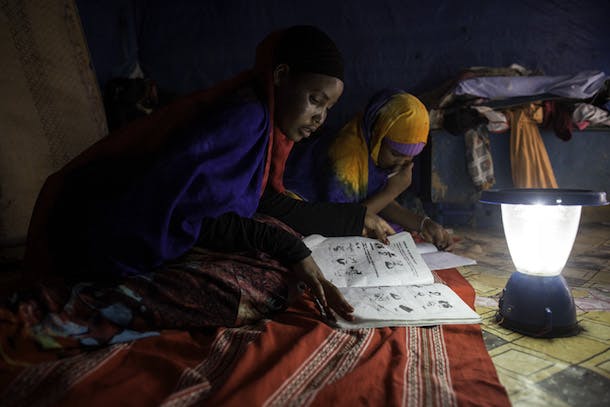
On World Refugee Day, June 20, the world turns its focus on the growing plight of refugees and displaced persons. More than 65 million individuals around the world today have been forced to flee their homes due to conflict and violence, and while many individuals and organizations hope to provide aid and relief through food, shelter, and medicine, a crucial resource is often overlooked – safe and reliable energy, light, and fuel for cooking.
Last month, the United Nations Foundation organized a webinar on “Decentralized Energy Solutions Focusing on Lighting and Powering in Humanitarian Settings,” in collaboration with the Clean Energy Solutions Center. The webinar featured a panel including the Global Alliance for Clean Cookstoves and the UN Refugee Agency (UNHCR), both members of the Safe Access to Fuel and Energy (SAFE) Humanitarian Working Group, along with the UN Foundation’s Energy, Climate, and Environment department. The private sector perspective was represented by Schneider Electric and Little Sun, both long-term members of the Foundation’s Energy Access Practitioner Network.
Here are four key takeaways from the presentations and moderated discussion.
Mind the energy gap: While the number and type of actors who are promoting safe access to fuel and energy (SAFE) practices in humanitarian settings has increased in the past decade, energy is currently not recognized as a formal part of humanitarian aid in the UN cluster system managed by the UN Office for the Coordination of Humanitarian Affairs (OCHA).
Similarly, while the needs of refugees and migrants are covered across multiple Sustainable Development Goals (SDGs), these populations are not specifically referenced in SDG7 – “sustainable and modern energy for all.” And the UN Agenda for Humanity lacks specific goals on energy access.
Meanwhile, according to a Chatham House Report, an estimated 89% of refugees in camps lack access to a reliable and modern energy source for lighting. Energy must be formally recognized as a priority at these policy levels to support meaningful, large-scale interventions in the field.
Planning short vs. long term: In humanitarian crises, immediate needs often limit practitioners’ ability to plan for the long term, but this approach is increasingly inefficient in a world where many refugees are living in camps for several years.
Short-term planning and budgeting cycles limit opportunities for energy solutions that require long-term planning and investments (e.g. solar PV systems compared to generators), especially where the financial break-even point may not manifest until a few years after installation. While solar lanterns can and have been added to non-food relief items kits, planning more extensive energy services to significantly improve quality of life, as well as to enable energy-dependent business opportunities, requires a long-term view for all actors involved, including donors, host communities, and host governments.
Show me the data: There is currently a dearth of data available that would help facilitate long-term planning. Studies looking at both the willingness and the ability of displaced people to pay for lighting or other energy services, as well as impact evaluations or assessments of needs for social infrastructure, such as health facilities and schools, would help bridge this gap.
Enter the private sector: To date, most of the energy products used in humanitarian settings are procured through competitive bidding procedures or are provided highly or fully subsidized based on a social motive (e.g. through corporate social responsibility). However, as more private sector actors enter the market, several initiatives are assessing market-based approaches to delivering energy products and services, including vouchers and cash transfers. This is further facilitated by technological advancements that improve the quality and lower the cost of products, most notably solar lanterns. While many barriers remain, the private sector is already playing a significant role in contributing expertise and skills to a market which is often under-resourced.
This webinar, part of EAPN’s series on best practices, hopes to inform audiences about the safe, reliable energy, cookstoves, and fuel that can help to power and empower the lives of refugees around the world. As we stand with refugees, let’s work to spur action and resources for their basic energy needs to light their homes, cook their food, and power their lives.



 View All Blog Posts
View All Blog Posts